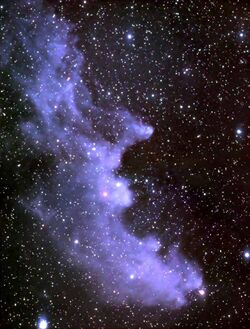Astronomy:IC 2118
| Reflection nebula | |
|---|---|
 IC 2118 | |
| Observation data: J2000 epoch | |
| Right ascension | 05h 02m 00.0s[citation needed] |
| Declination | −07° 54′ 00″[citation needed] |
| Distance | 1,000[citation needed] ly |
| Apparent magnitude (V) | 13[citation needed] |
| Apparent dimensions (V) | 3 × 1°[citation needed] |
| Constellation | Eridanus |
| Designations | Witch Head Nebula, Cederblad 41[citation needed] |
IC 2118 (also known as Witch Head Nebula due to its shape) is an extremely faint reflection nebula believed to be an ancient supernova remnant or gas cloud illuminated by nearby supergiant star Rigel in the constellation of Orion. The nebula lies in the Eridanus Constellation,[1] about 900 light-years from Earth. The nature of the dust particles, reflecting blue light better than red, is a factor in giving the Witch Head its blue color. Radio observations show substantial carbon monoxide emission throughout parts of IC 2118, an indicator of the presence of molecular clouds and star formation in the nebula. In fact candidates for pre-main sequence stars and some classic T-Tauri stars have been found deep within the nebula.[2]
The molecular clouds of IC 2118 are probably juxtaposed to the outer boundaries of the vast Orion-Eridanus bubble, a giant supershell of molecular hydrogen blown by the high mass stars of the Orion OB1 association. As the supershell expands into the interstellar medium, favorable circumstances for star formation occur. IC 2118 is located in one such area. The wind blown appearance and cometary shape of the bright reflection nebula is highly suggestive of a strong association with the high mass luminous stars of Orion OB1. The fact that the heads of the cometary clouds of IC2118 point northeast towards the association is strong support of that relationship.
See also
- New General Catalogue, IC is acronym for Index Catalogue
References
- ↑ "Witch Head Nebula". https://www.nasa.gov/multimedia/imagegallery/image_feature_1209.html.
- ↑ Kun; Prusti, T.; Nikolić, S.; Johansson, L. E. B.; Walton, N. A. (2004). "The IC 2118 association: New T Tauri stars in high-latitude molecular clouds". Astronomy and Astrophysics 418 (1): 89–98. doi:10.1051/0004-6361:20034510. Bibcode: 2004A&A...418...89K.
External links
- http://www.seds.org/
- NASA Astronomy Picture of the Day: Image of IC 2118 (29 December 2009)
- Witch Head Nebula at Constellation Guide
Coordinates: ![]() 05h 04m 54s, −07° 15′ 00″
05h 04m 54s, −07° 15′ 00″
 |

